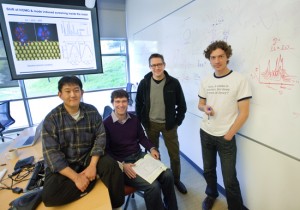By homing in on the distribution patterns of electrons around an atom, a team of scientists team with Berkeley Lab's Molecular Foundry showed how certain vibrations from benzene thiol cause electrical charge to 'slosh' onto a gold surface (left), while others do not (right). The vibrations that cause this 'sloshing' behavior yield a stronger SERS signal.
The mystery behind a detection method that can sense the presence of individual molecules–useful for researchers analyzing artwork and anthrax alike–has been unraveled by scientists with the Lawrence Berkeley National Laboratory (Berkeley Lab).
Raman spectroscopy is an analytic technique commonly used to gain insight into bonding configuration and symmetry in molecules. This technique uses light scattered by vibrations from atoms to provide scientists with a unique signal, or fingerprint, for a given molecule. However, for nanoscale materials and interfaces, this signal is far too weak to be detected.
Surface-enhanced Raman spectroscopy, or SERS, is a surface-sensitive technique capitalizing on the enhancement of a Raman signal from a molecule placed on a rough metal surface. This surface behaves like an array of antennas, amplifying a signal billions of times or more and making it easier to detect. In recent years, this technique has been used to identify faded pigments in watercolor artist Winslow Homer’s colorless skies, and proposed as a nanoscale sensor in biological warfare. However, the chemical aspect of this enhancement has baffled researchers for decades.
“The role of surface chemistry in SERS has been unexplained for more than thirty years,” says Alexey Zayak, a post-doctoral scholar working with Jeff Neaton, Director of the Theory of Nanostructured Materials Facility at Berkeley Lab’s Molecular Foundry, a U.S. Department of Energy (DOE) national nanoscience user facility. “Many theories have been proposed for why it occurs, but the chemical contributions to SERS were never established enough to draw a simple, systematic picture of this behavior. Working with experimentalists and with a new theoretical approach, we were able to isolate the chemical contributions.”
Previous efforts to understand the change in Raman signal of molecules attached to a metal surface have struggled to separate chemical contributions to enhancement. In this study, Zayak and Neaton performed quantum-mechanical calculations to show changes in Raman signal intensity caused by the chemical binding of benzene thiol, a ring-like organic molecule, onto a gold surface.
By homing in on how electrons are distributed around an atom, the team showed how vibrations from this molecule cause electrical charge to “slosh” from benzene thiol to the gold and trigger signal enhancement. Pinpointing this change in behavior provides a simple, straightforward understanding of chemical contributions to SERS.

Molecular Foundry scientists (from left) Hyuck Choo, Jim Schuck, Jeff Neaton, Alexey Zayak have shed light on the mystery behind the workings of surface-enhanced Raman spectroscopy. (Photo by Roy Kaltschmidt, Berkeley Lab Public Affairs)
“We wanted to find a model to isolate how this fingerprint of a molecule changes or becomes enhanced as it interacts with a surface. Here, we did a rigorous, controlled set of calculations that were validated by quantitative agreement with experiment. Our calculations provide a complementary dimension to experimental results, and helped us identify which of the existing models best explained both our calculations and the experimental data,” says Jeff Neaton, who is also acting deputy director for science in Berkeley Lab’s Materials Science Division. “The beauty of this work is our ability to quantitatively compare calculations with experimental results. This opened the door for a simple model that led to an unprecedented understanding of this elusive phenomenon.”
Now, using this model, other researchers can interpret chemical contributions to SERS in their own experimental data. What’s more, Zayak adds, this new understanding extends beyond Raman spectroscopy to “basically any situation where atomic vibrations are triggered at an interface between a molecule and a metal,” such as in catalysis and the flow of electrical charge or heat through nanoscale interfaces and molecular junctions.
A paper reporting this research titled, “Chemical Raman enhancement of organic adsorbates on metal surfaces,” appears in Physical Review Letters and is available to subscribers online. Co-authoring the paper with Zayak and Neaton were Y.S. Hu, Hyuck Choo, Jeff Bokor, Stefano Cabrini and Jim Schuck.
Portions of this work at the Molecular Foundry and the National Energy Research Scientific Computing Cluster were supported by DOE’s Office of Science.
The Molecular Foundry is one of the five DOE Nanoscale Science Research Centers (NSRCs), national user facilities for interdisciplinary research at the nanoscale, supported by the DOE Office of Science. Together the NSRCs comprise a suite of complementary facilities that provide researchers with state-of-the-art capabilities to fabricate, process, characterize and model nanoscale materials, and constitute the largest infrastructure investment of the National Nanotechnology Initiative. The NSRCs are located at DOE’s Argonne, Brookhaven, Lawrence Berkeley, Oak Ridge and Sandia and Los Alamos National Laboratories. For more information about the DOE NSRCs, please visit http://nano.energy.gov.
Lawrence Berkeley National Laboratory addresses the world’s most urgent scientific challenges by advancing sustainable energy, protecting human health, creating new materials, and revealing the origin and fate of the universe. Founded in 1931, Berkeley Lab’s scientific expertise has been recognized with 12 Nobel prizes. The University of California manages Berkeley Lab for the U.S. Department of Energy’s Office of Science. For more, visit www.lbl.gov.
Additional information:
For more information about the Molecular Foundry, visit the Website at http://foundry.lbl.gov/